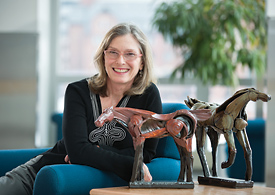Placed on top of Jeri Hollister’s kitchen table is a small sculpture, the clay manipulated to create the strong curves of the well-defined muscles on a brown horse.
“We had a bottomless sandbox in the backyard when I was a kid, and I used to dig down to the bottom where the soil was more clay-like and stuck together,” says Hollister, who incessantly drew pictures of horses as a young girl.

Photo by Scott C. Soderberg, Michigan Photography.
Despite an early interest in the arts, Hollister, who works as a program assistant at the Center for Research on Learning and Teaching, initially thought she would become a lawyer or something similar. However, as a student in the Residential College, she was exposed to new mediums of art. She changed her mind after taking art classes, and declared a major in history of art.
In particular, Hollister took an interest in an Asian ceramics class. It introduced her to Neolithic and later forms of ceramic art, such as tripod vessels that were, it is thought, used for cooking over a fire.
Influenced by the vessels, Hollister began to make her own versions of tripods, which soon developed into anthropomorphic figures, and other animals, such as birds. The animal-like tripod forms began to show up in her drawings, and eventually she transformed the figures in the drawings into abstract horses.
“I started drawing horses again, and they were very abstract, so I thought I’d try making my drawings three-dimensional,” says Hollister, who credits her fascination with horses to growing up in rural Michigan, living between her grandparents’ and uncle’s farms.
Hollister doesn’t just utilize her creative imagination when she is working with ceramics, but also in her work with the Center for Research on Learning and Teaching, which supports teaching at U-M across the entire university.
After spending 18 years in the history of art department, Hollister moved to CRLT eight years ago. Although much of her work is logistical in nature, CRLT has drawn on her artist’s eye in setting up a gallery of more than 20 posters that display innovative teaching projects along the office’s perimeter. Furthermore, her graphic design contributions are visible in several of the posters.
One of the larger programs for which Hollister is the lead logistical planner is the Rackham-CRLT Preparing Future Faculty Seminar.
“CRLT runs a seminar for graduate students in May that meets twice a week for five weeks. It teaches graduate students about life as academics, exposes them to different types of teaching institutions, and prepares them for the job search, ” says Hollister, who ensures that space, equipment, materials are in place for each session.
Hollister also organizes logistics for smaller programs for graduate students and postdoctoral scholars who wish to become teaching faculty, as well as for a teaching academy for new faculty in the health sciences. In addition, she assists in the administration of CRLT’s various grant programs and helps keep the website and many CRLT publications updated.
Outside of her job duties as a program assistant, Hollister is a member of the Potters Guild, an artists’ cooperative on Hill Street, which has been in existence for more than 60 years.
Hollister is able to sell her work not only at the Potters Guild, but also in galleries in Michigan, Ohio, Georgia, Tennessee and Florida, as well as at an online gallery website.
The weekly Spotlight features faculty and staff members at the university. To nominate a candidate, please contact the Record staff at [email protected].

